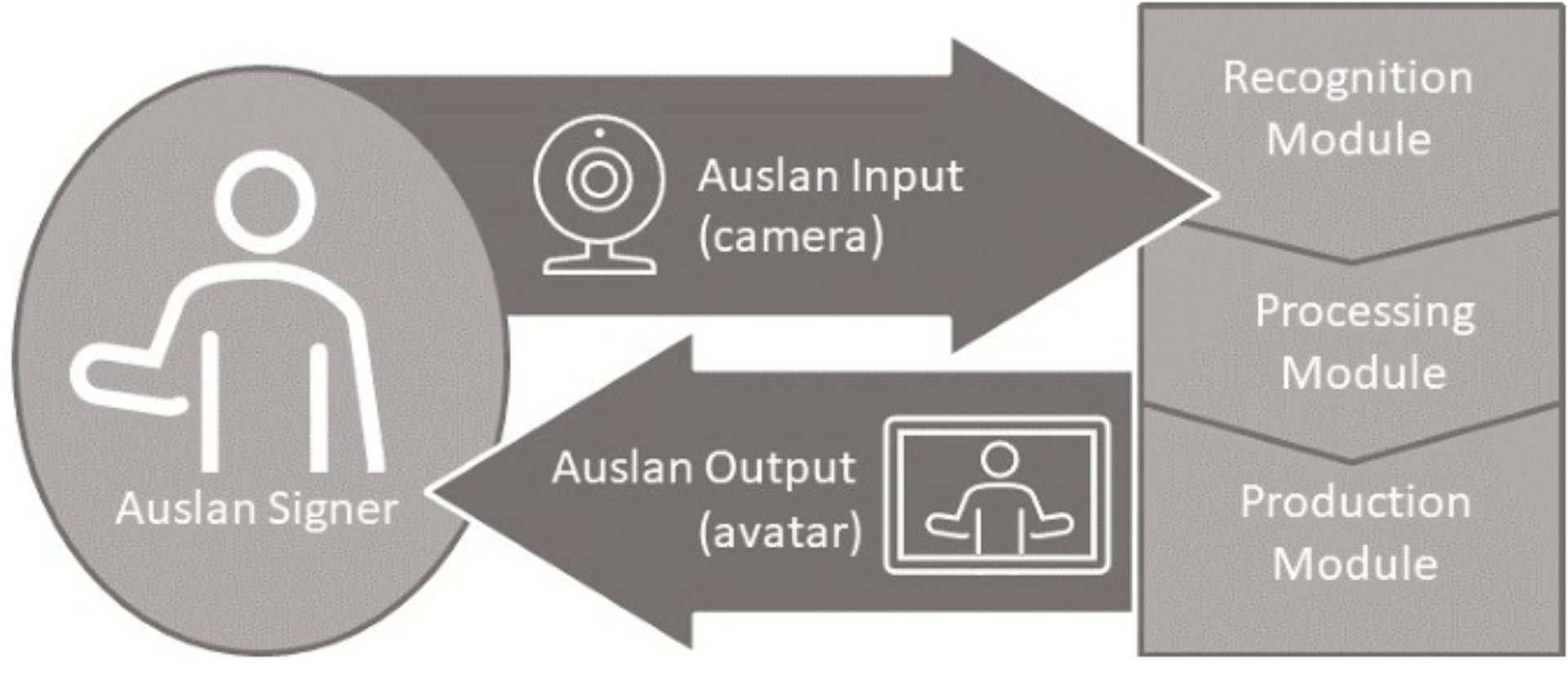“Visual-gestural Interface for Auslan Virtual Assistant”
Conference:
Experience Type(s):
Title:
- Visual-gestural Interface for Auslan Virtual Assistant
Organizer(s)/Presenter(s):
Description:
For Deaf people to use natural language interfaces, technologies must understand sign language input and respond in the same language. We developed a prototype smart home assistant that utilises gesture-based controls, improving accessibility and convenience for Deaf users. The prototype features Zelda, an interactive signing avatar that provides responses in Auslan (Australian Sign Language), enabling effective two-way communication. Our live demonstration includes gesture recognition and sign production.
References:
[1]
Danielle Bragg, Oscar Koller, Mary Bellard, Larwan Berke, Patrick Boudrealt, Annelies Braffort, Naomi Caselli, Matt Huenerfauth, Hernisa Kacorri, Tessa Verhoef, Christian Vogler, and Meredith Ringel Morris. 2019. Sign language recognition, generation, and translation: An interdisciplinary perspective. In ASSETS ’19. Pittsburgh, PA, USA, 16–31. https://doi.org/10.1145/3308561.3353774
Digital Library
Google Scholar
[2]
Necati Cihan Camgoz, Ben Saunders, Guillaume Rochette, Marco Giovanelli, Giacomo Inches, Robin Nachtrab-Ribback, and R. Bowden. 2021. Content4All open research sign language translation datasets. In FG 2021. 1–5.
Google Scholar
[3]
Aashaka Desai, Lauren Berger, Fyodor O Minakov, Vanessa Milan, Chinmay Singh, Kriston Pumphrey, Richard E Ladner, Hal Daumé III, Alex X Lu, Naomi Caselli, and Danielle Bragg. 2023. ASL Citizen: A Community-Sourced Dataset for Advancing Isolated Sign Language Recognition. arXiv preprint arXiv:2304.05934 (2023).
Google Scholar
[4]
Trevor A Johnston. 2008. Auslan Corpus. https://elar.soas.ac.uk/Collection/MPI55247
Google Scholar
[5]
Trevor A Johnston and Adam Schembri. 2010. Variation, lexicalization and grammaticalization in signed languages. Langage et société 1, 131 (2010), 19–35.
Google Scholar
[6]
Jessica Korte, Axel Bender, Guy Gallasch, Janet Wiles, and Andrew D. Back. 2020. A plan for developing an Auslan Communication Technologies Pipeline. Lecture Notes in Computer Science 12536 (2020), 264–277. https://doi.org/10.1007/978-3-030-66096-3_19
Digital Library
Google Scholar
[7]
Jessica Korte, Julie Lyons, and Adele Vogel. 2022a. Auslan personal assistant functionality identified through interviews. Technical Report. TAS DCRC and DSTG.
Google Scholar
[8]
Jessica Korte, Adele Vogel, and Maria Zelenskaya. 2022b. Maximising usability of an avatar for visual-gestural user interfaces. Technical Report. TAS DCRC and DSTG.
Google Scholar
[9]
Verena Krausneker and Sandra Schügerl. 2021. Best practice protocol on the use of sign language avatars. Technical Report. University of Vienna, Vienna, Austria. 1–17 pages. https://avatar-bestpractice.univie.ac.at/
Google Scholar
[10]
Razieh Rastgoo, Kourosh Kiani, and Sergio Escalera. 2021. Sign language recognition: A deep survey. Expert Systems with Applications 164 (2021), 113794. https://doi.org/10.1016/j.eswa.2020.113794
Crossref
Google Scholar
[11]
Panneer Selvam Santhalingam, Al Amin Hosain, Ding Zhang, Parth Pathak, Huzefa Rangwala, and Raja Kushalnagar. 2020. MmASL: Environment-Independent ASL Gesture Recognition Using 60 GHz Millimeter-Wave Signals. Proc. ACM Interact. Mob. Wearable Ubiquitous Technol. 4, 1, Article 26 (mar 2020), 30 pages. https://doi.org/10.1145/3381010
Digital Library
Google Scholar
[12]
Xin Shen, Shaozu Yuan, Hongwei Sheng, Heming Du, and Xin Yu. 2023. Auslan-Daily: Australian Sign Language translation for daily communication and news. https://uq-cvlab.github.io/Auslan-Daily-Dataset/
Google Scholar
[13]
Shashindi Vithanage. 2022. Auslan Alexa: VR “Wizard of Oz”. Honours. The University of Queensland.
Google Scholar
[14]
Shashindi Vithanage, Arindam Dey, and Jessica Korte. 2023. ’Auslan Alexa’: A case study of VR Wizard of Oz for requirements elicitation. In IEEE Conference on Virtual Reality and 3D User Interfaces. IEEE, Shanghai, 911–912. https://doi.org/10.1007/978-3-030
Crossref
Google Scholar
[15]
World Federation of the Deaf and World Association of Sign Language Interpreters. 2018. WFD and WASLI statement on use of signing avatars. https://wfdeaf.org/news/resources/wfd-wasli-statement-use-signing-avatars/
Google Scholar





